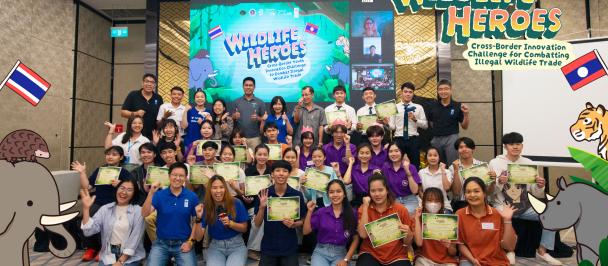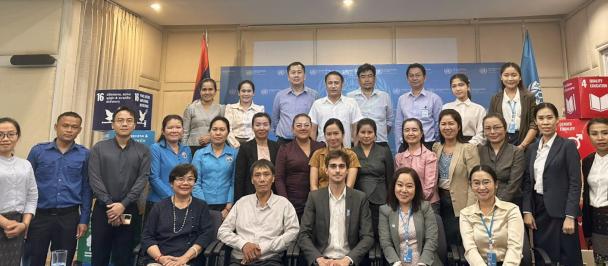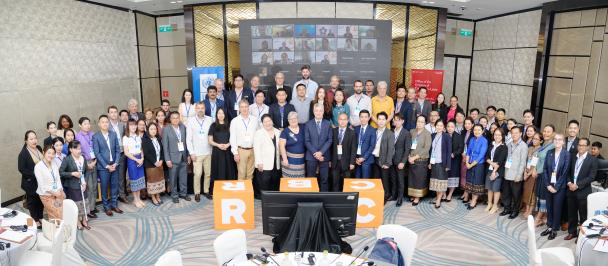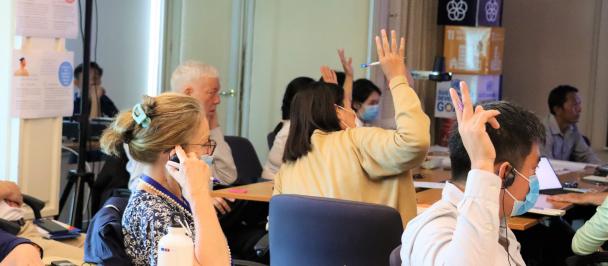This blog post is the first part of a two-blog series that shares the Lao PDR Accelerator Lab journey in applying Collective Intelligence to help Sikhottabong district understand its problem on open burning.
Why do we need Collective Intelligence (CI) for solid waste management?
August 24, 2020
Photo by: UNDP Lao PDR
Collective Intelligence: What is it?
First, what is Collective Intelligence (CI)? To put it simply, it is intelligence shared by a group of people. This knowledge emerged from collaboration, collective efforts, and contributions from various individuals.
CI aims to distill ideas and concepts gathered from the public to make better and smarter decisions for the challenges they faced. According to Malone (2018), Collective Intelligence connects people, data, and technology, and it occurs when groups of individuals collaborate in a way that seems perceptive.
Openstreetmap.org is an excellent example of CI. This platform allows people from all around the world to create more concise and up-to-date street maps. Users from anywhere can log in and contribute their thoughts and knowledge to identify buildings, landmarks, and national parks in their area. This platform has helped public and private agencies to access accurate information and to design proper interventions for several different challenges.
What are the critical insights from Collective Intelligence?
We found CI to be a useful tool to tackle complex questions. It helped us gather collective thoughts from various stakeholders and direct beneficiaries. Unlike Behavioral Insights (BI), which has its core focus on prompting people to decide based on expected results or outcomes, CI is a bottom-up approach emphasizing community and individual empowerment. It encourages beneficiaries to feed in their thoughts and knowledge to improve decision-making processes. The issue of solid waste management needs collective actions and involvement from all sectors.
CI could help tackle challenges through 4 components: to understand problems; to seek solutions; to decide and act; and to learn and adapt. This process has helped Accelerator Labs to raise awareness of, and confidence in using CI tools, processes, and principles.
The method also encouraged the teams to explore and experiment with novel ways of working with people, data, and technology. And, it aimed to ensure reflection on the learning of the Accelerator labs and to make progress on current projects.
Our Challenges on Open Burning
Vientiane, home to nearly a million people, is facing challenges from air pollution, similar to major industrial cities. Data from AQI of 4 major spots around the town (UNDP AQI report May 2020), revelaed that from October 2019 to May 2020, the air quality in Vientiane was unhealthy to extremely unhealthy.
From the pre-workshop assignment, we have discovered new aspects about the issues. Here is our initial hypothesis, combined with results from our observation before joining the workshop:
Hypothesis 1 “people burn their trash because they do not have access to waste collection services or could not afford to pay the service fees.”
At the CI workshop during the first quarter of 2020, we mainly explored the primary components of CI, as to the extent we could use CI to understand problems. According to a group discussion, most country offices still showed some struggles in defining a real problem on waste management; therefore, the context of the workshop has been circumvented around the concept of exploring and identifying problems.
From that exercise, we have found new insights from other countries that have helped us rethink and make a bold move towards solid waste management in Vientiane, particularly regarding open burning.
Figure 1. Waste collection map of a sample village in Sikhottabong district.
Instead of focusing mainly on creating a waste collection system for communities lacking such services, we found that people openly burn their trash anywhere and everywhere, despite the availability of waste collection services within communities. This finding helped us pivot and narrow down the focus.
Figure 2. Waste journey of Sikhottabong District
We focused on what may have motivated people to burn openly and not consider such consequences. Moreover, discussions and lessons shared from other Accelerator Labs had given us some critical insights on solid waste management.
We learned that in Vietnam, people refused to use waste collection services despite the lower fee. Local communities in Danang preferred to sell their household trash to informal waste pickers for a small financial gain.
In Tanzania, however, being a waste picker is an occupation where ID and training are needed before becoming one. This system helped waste pickers to earn more income and aided the local government on solid waste management challenges.
In rural communities of Ukraine, the open burning of organic waste is typical and frequent regardless of the availability of collection services and low fees (1.5 USD per month). By putting all these pieces together, it guided us to where we should focus and further explore questions on whether we followed the right path to address challenges of solid waste management in Vientiane.
What’s next?
We have embarked on an eight-week learning journey, where we have worked closely with Nesta, Local communities, and Geographic Information System experts to understand the real problem of open burning in 3 pilot communities in Vientiane, through the CI approach.
In our next and final blog of this series, we will take you on a journey of how we utilized CI tools to understand the problem of open burning, and how novel data helped us see the problem in a bigger picture.
Written by:
Khavi Homsombath, Head of Experimentation, Accelerator Lab, UNDP Lao PDR
The views expressed in this article are those of the author alone and not the United Nations Development Programme.

 Locations
Locations




